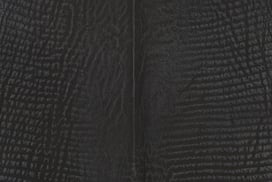Knowing the defining qualities of exotic leathers is key for choosing the right one for your needs. For example, some hides are soft and flexible, while others are rigid and tough. So, what are the qualities of shark leather?
In a recent post, we discussed some of the most popular uses of shark skins—such as for boots and belts—but what are the qualities of shark leather that make the hide ideal for such uses? 
To help you learn more about exotic skin qualities (and shark hide in particular), here’s a short list of some of the qualities of shark leather that you should know:
Water Resistance
As an aquatic hide, shark skin is inherently resistant to water—similar to stingray skin and eel skin. However, while shark skin itself does not readily absorb water, the finish of a piece of shark leather may be adversely affected by prolonged exposure to water.
When ordering shark leather, it helps to check with the supplier how the finish will be affected by water if you plan on using the leather for a product that will be exposed to water.
Shark Leather Texture
Shark skin is covered in a layer of “dermal denticles,” or tooth-like formations with a sharp point. If not ground down, these denticles create a rough texture for the hide when moving against the “grain” of the skin. In fact, these denticles are sharp and tough enough that one common use of shark skin is as a type of sandpaper!
Many tanneries opt to grind down the rough edges off their shark skins, making them smoother and less likely to cause scrapes from careless handling. This results in a deep natural pebble.
A side benefit of shark skins being covered in these miniscule scales is that it makes the hide more resistant to casual abrasions—so it’s less likely to show scratches. However, shark skin is not as scratch-resistant as stingray leather, which is covered in small, hard calcium beads.
Flexibility
Normally, a hide covered in tough scales is not very flexible. However, shark skin scales are very small, which allows the hide to flex with relative ease. When processed in a way that strips or sands down the dermal denticles, shark leather can be made more flexible (and softer to the touch).
Size and Grading
Because PanAm’s shark skins come from wild sources, the size and grade of skin available can vary significantly. On average, shark hides tend to be about 30” long and 20” wide at their widest point—with the hide tapering to 4” wide at the narrowest point.
Grading for shark leather is based on the number of scuffs, scratches, or scars present in the two main sections of the hide above and below the center fin hole. A grade 1 shark skin would have no significant defects in these sections, while a grade 4 piece of skin would have multiple defects in both halves of the hide.
It is common for shark skins to have bite marks from other blue sharks because of their mating rituals. As noted by animaldiversity.org, “Mating begins when a male bites a female between her first and second dorsal fins.” So, hides coming from mature blue sharks will frequently have a few bite marks.
Want to know more about the characteristics and uses of shark leather? Reach out to the exotic leather experts at PanAm Leathers today!



